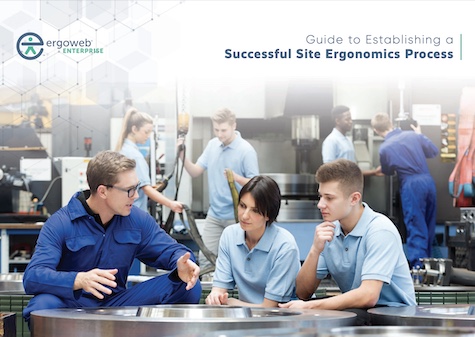A step-by-step guide to planning an effective ergonomics process at a company site or facility.

This is a brief summary article — for more detail and specific guidance on this topic, download our 10-page Guide to Establishing a Successful Ergonomics Process.
If you’re responsible for setting up an ergonomics process at your company site or facility, you may be wondering how to do it, or even where to start. Here is some evidence based guidance drawing on Ergoweb’s 25+ years of industry experience.
Milestone: Plan Your Site Ergonomics Process
Step 1: Gather key Information
It’s vital to understand the “current state” of ergonomics at your site. Gather and organize injury and workers’ comp data to identify hotspots. Productivity and quality data can also reveal bottlenecks and error prone processes that may have ergonomics issues at their root.
You’ll also want to understand where change is already planned, including such things as new product introduction, improvement initiatives, capital improvements. Also identify any ergonomics-related requirements applicable to the organization, including corporate, regulatory and industry based standards or guidelines.
[Related: Ergonomics Standards and Guidelines]
Step 2: Gain Leadership Endorsement
An ergonomics process relies on contributions of people throughout the organization, and resources from various departments may be needed and department managers may have to decide between conflicting priorities on a daily basis when allocating resources. It’s important to have specific improvement goals for ergonomics that are endorsed by the site leadership team, with clearly defined roles and responsibilities for the ergonomics process.
Be sure to read 5 Essential Elements of a Successful Ergonomics Process before developing your goals. This 14-page Guide describes many of the activities that you might want to include.
Without up-front endorsement of your goals and resources by leadership, you will have virtually no chance of achieving the goals, so this is an important step.
Step 3: Develop a Site Ergonomics Plan
Creating an annual plan is a matter of translating the goals into specific actions planned over 12 months (you’ll also want a 3-5 year plan). Take into account any trends, hot spots, and planned changes you identified in Step 1 to target actions where they can have the greatest impact.
Some companies identify ergonomics assessment methods, software, and design guidelines as corporate standards. If your company has not done this, you’ll want to research available options and select the tools that are a good fit for your site. Why Standardize Your Workplace Ergonomics Assessment Tools? and Ergoweb’s Guide to Picking the Best Ergo Analysis Tool for the Job are helpful for understanding the different types of ergonomics assessment methods available.
Communicate your plan to leadership and seek their input. Oftentimes, they’ll have knowledge of competing activities and may provide insights to avoid potential pitfalls and leverage available resources.
We’ve created a spreadsheet template with examples that you can use to plan your process: Download Ergoweb’s Site Ergonomics Planning Template.
Milestone: Launch Your Process and Maintain Progress
Step 4: Communicate Key Ergonomics Metrics
With a plan that has the support of leadership, you can focus your efforts on “working the plan”. Three key responsibilities of a site ergonomics leader or team that fall into the launch stage are:
- Communicate key ergonomics metrics to business leadership
- Share good/best practices for ergonomics
- Monitor effectiveness of the site ergonomics processes
Step 5: Share Good/Best Practices
Ergonomics is a problem solving process, and typically, similar problems exist in multiple locations. Likewise, a solution that works in one location may have merit in other locations. Successful ergonomics processes have robust methods for sharing effective ergonomics improvements.
Step 6: Monitor Effectiveness of the Ergonomics Process
The first year of launching a systematic ergonomics process at a site involves new activities and requires good communication and coordination. In subsequent years, the process will become more routine, and ergonomics improvement activities will naturally be less visible to leadership and managers. It’s important to systematically monitor effectiveness of the site ergonomics process and make enhancements to improve the impact.
For more detail and specific guidance on this topic, download our 10-page Guide to Establishing a Successful Site Ergonomics Process.
